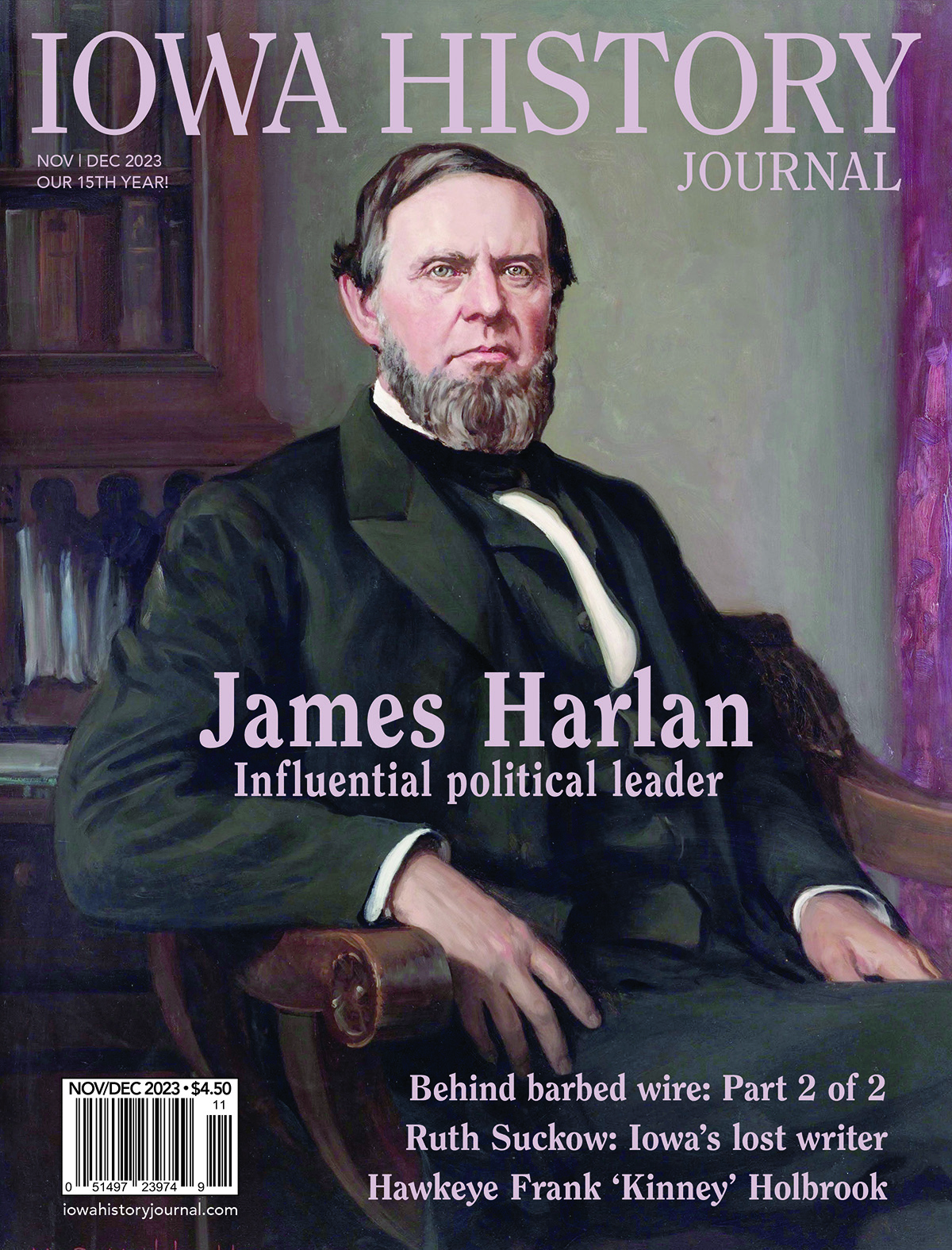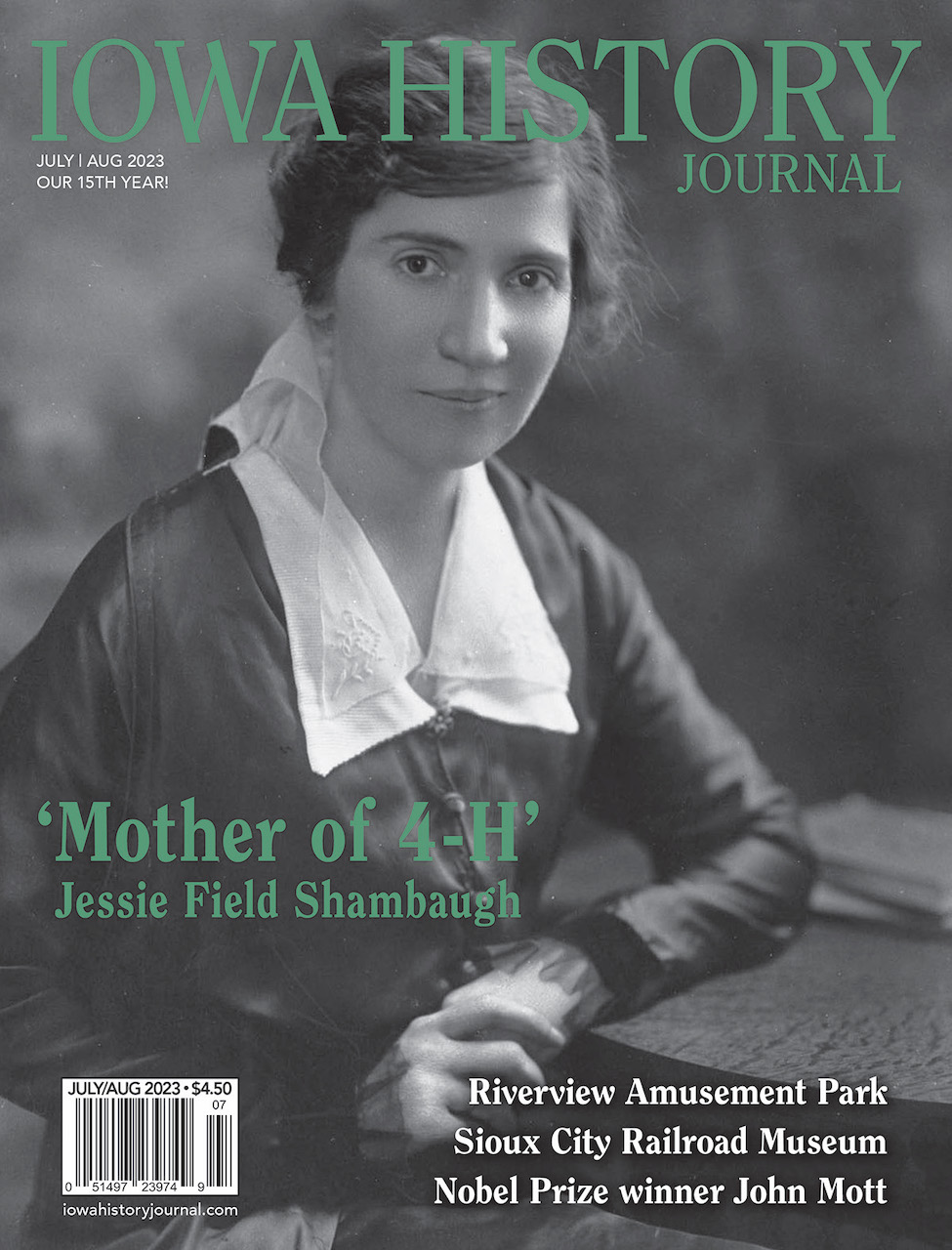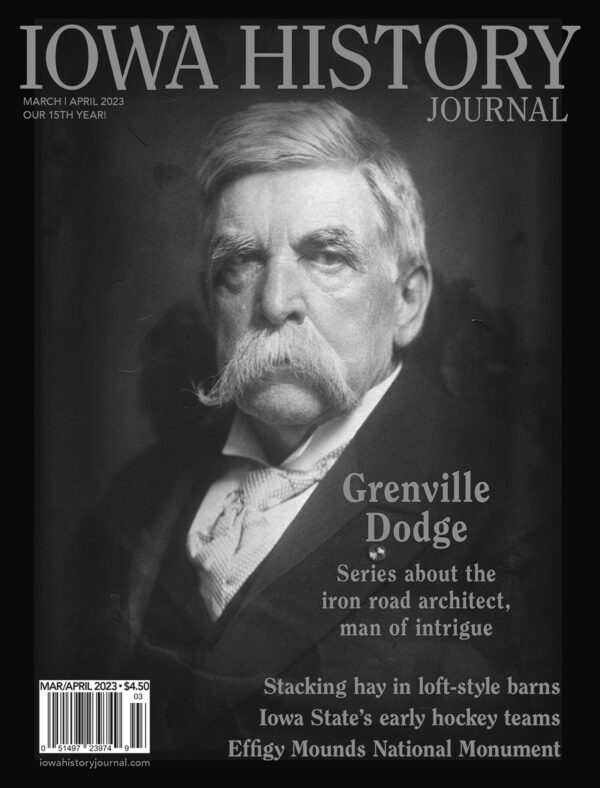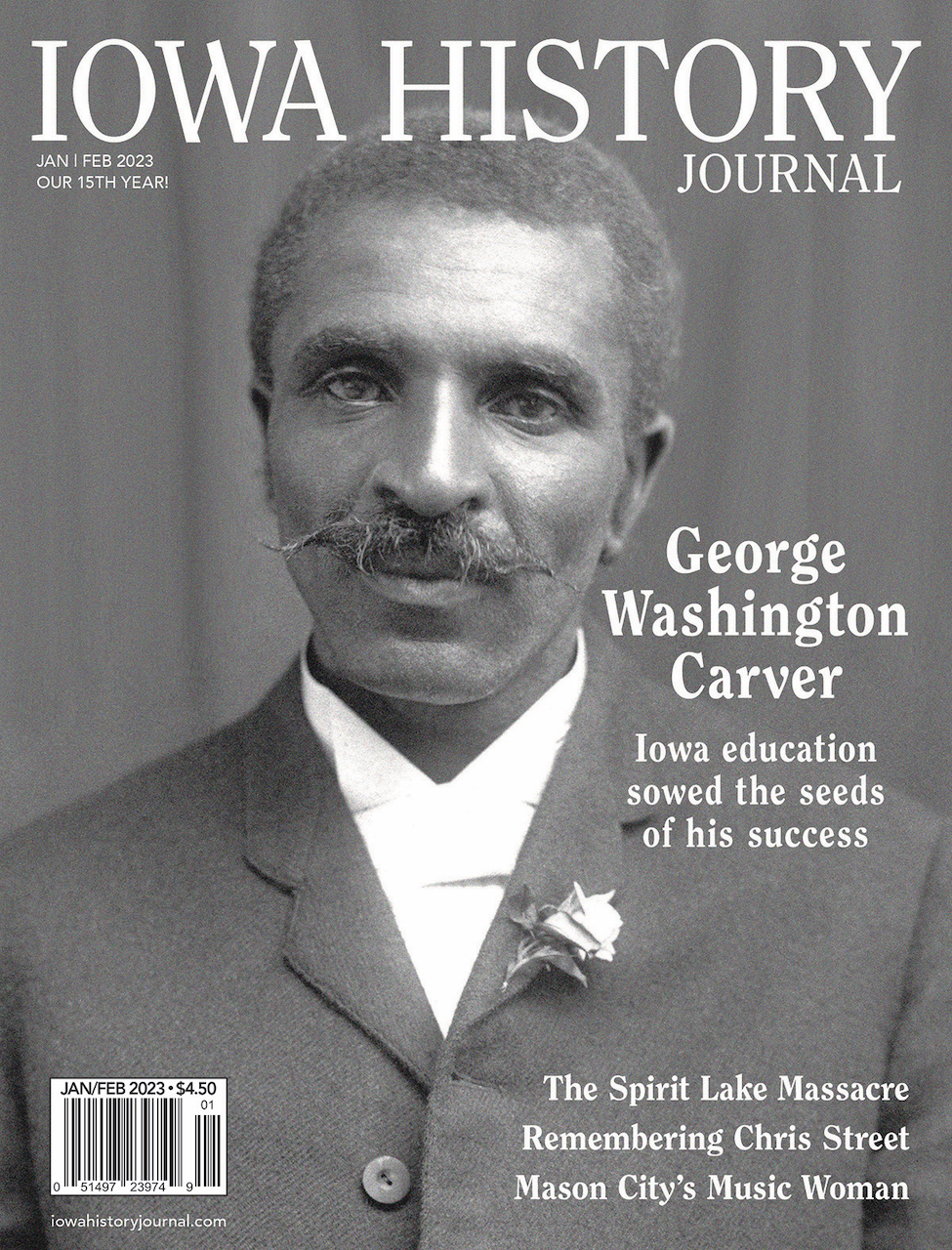 Volume 15, Issue No. 6, Nov/Dec 2023
Volume 15, Issue No. 6, Nov/Dec 2023
The historical legacy of James Harlan of Mount Pleasant, an influential political leader during the 19th century, stands strong today due to the indelible impact he made on the history of Iowa and the nation. One of the founders of the Iowa Republican Party and a staunch anti-slavery advocate, Harlan was twice elected to the U.S. Senate and was appointed by President Abraham Lincoln as Secretary of the Interior at the end of the Civil War, making Harlan the first Iowan to serve on a federal cabinet. A close friend of Lincoln, Harlan established himself within the president’s family when the Iowan’s daughter married the Great Emancipator’s eldest son. Read award-winning writer Jerry Harrington’s cover story about Harlan to learn about one of Iowa’s most influential political leaders.
Publisher Michael Swanger devotes his column to encouraging Iowans to give the gift of Iowa History Journal during the holidays and the popularity and importance of magazines.
Barbara Lounsberry, Emerita Professor of English, University of Northern Iowa, and President of the Ruth Suckow Memorial Association, pays tribute to renowned Iowa writer Ruth Suckow.
Discover the story of Frank “Kinney” Holbrook, the Tipton native who was Iowa’s first Black football player from Quinn Early, retired NFL player and Hawkeyes football and track star, who now works as a stuntman, writer and producer in Hollywood.
Go behind the gates at Camp Clarinda, which housed German and Japanese World War II POWs as told by retired newspaperman Don Doxsie in the second of his two-part series, “Behind barbed wire.”
Country Roads columnist Arvid Huisman reminds readers how Thanksgiving is always good for the soul.
 Volume 15, Issue No. 5, Sept/Oct 2023
Volume 15, Issue No. 5, Sept/Oct 2023
When World War II ended in 1945 there were more than 500 POW camps in the U.S., including two primary camps in Algona and Clarinda. There were also several smaller branch camps scattered throughout Iowa. Read the first part of our riveting two-part series “Behind barbed wire” written by award-winning author Don Doxsie to learn how German and Italian POWs lived and worked in Camp Algona as well as how they helped local farmers and created an enduring symbol of peace that remains today.
Publisher Michael Swanger writes his column about Halloween urban myths, legends and folklore across the state.
Discover the overlooked story of Gwendolyn Wilson Fowler, a pioneering pharmacist, chemist and Vietnam FOA analyst from retired State Historical Society of Iowa curator Jerome Thompson and his research in the University of Iowa’s archives.
Retired history professor John Liepa researches Toledo native and Chicago Cubs pitcher Leonard “King” Cole who won the 1910 Rookie of the Year Award.
Get an entertaining overview of seven decades of eastern Iowa television from KXEL radio host and author Jeff Stein.
Country Roads columnist Arvid Huisman recalls his bittersweet and humorous memories of going back to school decades ago.
TO READ MORE FASCINATING STORIES ABOUT IOWA HISTORY, subscribe to Iowa History Journal. You can also purchase back issues at the store.
 Volume 15, Issue No. 4, July/Aug 2023
Volume 15, Issue No. 4, July/Aug 2023
Shenandoah native and renowned educator Jessie Field Shambaugh devoted her life to improving the lives of those in rural areas across Iowa and our nation. Best known as the “Mother of 4-H,” she also gained national recognition for founding the Boys Corn and Girls Home clubs in Page County where she worked as a teacher and taught students how to “learn by doing.” She also was a school superintendent, author and appointed secretary for the national YWCA. Iowa State University’s Dr. Janice Nahra Friedel provides an overview of Field’s trailblazing work in this issue’s cover story.
Iowa History Journal Owner and Publisher Michael Swanger devotes his “Publisher’s Perspective” column to MLB umpire Don Denkinger’s great career and good character.
Explore the Sioux City Railroad Museum with Arvid Huisman as he explains how the museum recalls Siouxland’s railroad heritage.
John Busbee, host of radio’s “The Culture Buzz,” contributes a summertime story about the history of Riverview Amusement Park and how “The Coney Island of Iowa” entertained visitors along the Des Moines River from 1915 to 1978.
Discover the story of John Mott, Postville’s renowned evangelist, Nobel Peace Prize winner and longtime leader of the YMCA from KXEL radio host and author Tim Harwood.
Country Roads columnist Arvid Huisman shares some of the country wisdom he learned while growing up in small towns in Iowa.

Artwork from McCall’s 1975 album “Black Bear Road.”
Volume 15, Issue No. 3, May/June 2023
William Fries Jr., a.k.a. C.W. McCall, was best known for his 1975 chart-topping, trucking anthem “Convoy” though he was more than a one-hit wonder. The Audubon native was an award-winning advertising executive who wrote popular jingles for Old Home Bread and Union Pacific Railroad before achieving fame as a country and western music singer who became the deep voice of the CB craze during the 1970s. He lived most of his adult life in Colorado, but he never forgot his Iowa roots, writing songs that referenced the Hawkeye State including “Audubon,” “Old Home Filler-up an’ Keep on-a-Truckin’ Cafe” and “Classified.” Iowa History Journal Owner and Publisher Michael Swanger, a former music critic, logs the life and times of one of the most remarkable and successful musicians to emerge from Iowa.
Iowa History Journal Owner and Publisher Michael Swanger writes about how Iowa got its shape in his “Publisher’s Perspective” column.
Author Timothy Walch concludes his riveting series about Grenville Dodge, delving into his military career and how he helped evolve our nation’s military intelligence.
Get the score on the history of baseball’s Dubuque Packers from Dubuque historian John Pregler and how they became the Kansas City Royals’ first farm team.
Explore the Lock and Dam No. 19 Historic District in Keokuk on the Upper Mississippi River with Carson Ode.
Schools out! Country Roads columnist Arvid Huisman recalls the joy of end-of-the-year school picnics.

A portrait of Grenville Dodge taken in 1911. Photo retrieved from the Library of Congress, https://www.loc.gov/item/2014683571/
Volume 15, Issue No. 2, Mar/Apr 2023
Grenville Dodge lived a life of extraordinary adventure. He was an explorer and a hunter, a farmer and a shopkeeper, a Union general and a congressman. He cheated death during the Civil War and died a wealthy man. His lifelong passion was the great iron road, serving as an architect of the transcontinental railroad that linked the nation from sea to sea at Council Bluffs. Dodge left an indelible mark on Iowa and the nation and is the subject of our intriguing two-part series written by Timothy Walch.
Publisher Michael Swanger thanks readers for their support of Iowa History Journal as it celebrates its 15th anniversary and shares with them his experience of having owned the magazine for 10 years
“Hay” there! Join guest columnist Clark BreDahl recalls his hay-making days and loft-style barns in Adair County.
Explore the history of the Effigy Mounds National Monument — the American Indian sacred sites located in the spectacular Upper Mississippi region as shared by Carson Ode.
Meet the ice breakers. Waterloo sportscaster and author Tim Harwood scores the history of Iowa State University’s early hockey teams.
Country Roads columnist Arvid Huisman writes about traveling the Hawkeye State and his friendly encounters with fellow Iowans in every county.

A portrait of famous agricultural scientist and inventor George Washington Carver, circa 1910. Photo courtesy of Tuskegee University Archives/Museum
Volume 15, Issue No. 1, Jan/Feb 2023
George Washington Carver, a brilliant, ambitious son of a slave became one of the greatest agricultural scientists of his time, admired and respected by people all over the world. It is likely none of his success would have occurred had it not been for his mentors at Simpson College and Iowa State Agricultural College (now Iowa State University) who saw his potential and encouraged him. Carver would become the first black student admitted to Iowa State as well as its first black graduate student and faculty member before achieving worldwide fame.
Iowa History Journal kicks off its 15th year of publication with a riveting story about Carver’s education and time spent in Iowa written by former Iowa newspaperman and longtime IHJ contributor John Skipper, who died before his story about Carver went to print. We dedicate this issue to the memory of Skipper, a consummate professional journalist and friend whose stories for years informed and entertained IHJ’s readers
Publisher Michael Swanger writes his column about how Hamlin Garland’s memories of winter remind us when we were a hardy lot.
Iowa Hawkeyes basketball star Chris Street is remembered 30 years after his tragic death and we take a look back at Carver-Hawkeye Arena, which was built 40 years ago with retired Quad City-Times sports editor Don Doxsie.
State Historical Society of Iowa Curator Leo Landis covers writer Dixie Willson, Mason City’s “Music Woman,” and her complex relationship with her famous brother Meredith Willson
Navigate the tragic undercurrents that preceded the muddied waters of the Spirit Lake Massacre in 1857 with Cheryl Tevis, farmer and former Successful Farming editor.
TO READ MORE FASCINATING STORIES ABOUT IOWA HISTORY, subscribe to Iowa History Journal. You can also purchase back issues at the store.
